One Step Closer to Captive-Raised Mandarins
By Matthew L. Wittenrich
“The voyage of discovery lies not in finding new landscapes, but in having new eyes.” —Marcel Proust
Not too long after my Breeder’s Guide was released, I was confronted by people asking, “Why aren’t mandarins in the book?” My answer was quite simple: I never really thought about it. In fact, I realized that I had been shunning mandarins for many years.
When I was 12 years old I set up my first marine aquarium. Determined to fill my system with bold and beautiful colors from around the world, at the local fish store my eyes were quickly drawn to, and engulfed, by fluorescent stripes and swirls of green and blue. As the bright blue pectoral fins undulated wildly against the bright orange background color and the long dorsal fin flashed high above the body, my imagination had been won over; I purchased my first mandarin, Synchiropus splendidus, (sometimes sold as the Striped or Psychedelic Mandarin).
Within days my newfound fascination was showing signs of stress as he tirelessly hunted the captive reef for prey. Days and weeks went on as he grew thinner and ever more emaciated. My most-prized fish slowly tired and died. I vowed never to purchase another.
New Hope for a Star-crossed Species
Fourteen years after purchasing my first mandarin my eyes were drawn back.
This time it took more than becoming mezmerized by one in a local pet shop. I was finally inspired by a community of dedicated aquarists who were proving that mandarinfishes could not only be maintained successfully in home aquariums, but they could also be propagated.
I had heard of various reports of German aquarists raising a few mandarins and even tracked down a copy of Wolfgang Mai’s successful journey with spotted mandarins in Coral Magazine.
But, I still wasn’t convinced that caring for them was going to be easy. Then, I found MOFIB. The Marine Ornamental Fish and Invertebrate Breeders website, commonly known as the MOFIB Forum, has assembled a wealth of information from hobbyists all over the world. The brainchild of Matt Pedersen, MOFIB illustrates how far the marine aquarium hobby has come in just a short while.
Matt has posted some wonderful information and photographs of his personal experience with mandarins, and it was here that my excitement was renewed. Breeding marine fishes in small glass bowls is certainly an adventure. Having a group of dedicated friends to help along the way is a tremendous asset.
The Fish
The Green Mandarin, Synchiropus splendidus, is an undeniably popular marine fish with a faithful audience of SCUBA divers, aquarium enthusiasts, photographers and conservationists. Mandarins are surely deserving of the name psychedelic as it seems every fin and every part of the body is patterned with contrasting shapes and colors. This is also one of the most recognizable marine fishes in the hobby and one of few that are responsible for getting so many people involved in saltwater aquariums.
Unfortunately, the Green Mandarin, along with its congener the Spotted Mandarin, Synchiropus picturatus, also exhibit one of the highest rates of mortality among captive marine fishes. Until a few years ago it was a challenge to keep one alive for more than a few months. Due to their tiny mouths and strong preference for small, live, crustacean prey, mandarins are difficult to feed in aquariums and most suffer from starvation.
Today, dedicated hobbyists are weaning their mandarins to accept frozen and even pelleted foods and, with a bit of patience, mandarins are no longer a “for experts only” fish.
Secrets of Mandarin Feeding
In order for mandarins to thrive in a captive environment, they must be supplied with sufficient high-protein foods.
There are two commonly approached methods and one certainly produces better long term results. It has long been said that in order for mandarins to survive, a large, mature, rock-filled aquarium was needed. The idea being that harpacticoid copepod populations present on a large surface area of live rock would support the near-constant foraging behavior of this fish.
While this method can work to support the dietary demands of a mandarin, it is far too prone to failure in closed systems. (Aquarists often over-estimate the productivity of their reef systems or stock species that compete for the limited crops of microfauna.)
Refugiums help support copepod populations, but all too often mandarins slowly suffer from starvation in such settings. A much more realistic and successful approach involves weaning mandarins off a strictly live food diet and teaching them to accept frozen foods, such as mysis shrimp, that are readily available.
The best method in my opinion was developed by Matt Pedersen of MOFIB (see the links below). The idea is quite simple. Isolate new mandarins in suspended breeder baskets (or small quarantine tanks) and get them feeding on enriched live brine shrimp. Then, introduce frozen brine shrimp and mysis shrimp. After the fish begin sampling the frozen fare the live diet is slowly replaced. Once they are eating frozen fare with vigor they are released into the display tank where their “training” pays off.
Broodstock Beginnings
As I wandered into the local fish shop to initiate my new project I was immediately drawn to a tiny acrylic display cubicle holding a newly arrived male green mandarin. Then, my eyes were drawn to another male two cubicles over, and before I knew it I was pacing back and forth watching and trying to decide among six males that had all arrived the previous day. (For some background on why the selection was limited to males, see this Sidebar Article: Mandarin Harvest Realities.
I finally decided on three large active ones, bagged them up and took them home. I placed each male in a separate aquarium and tried to fatten them up while awaiting the arrival of some females at the shop. Within three days one of the males died. The other two became quite rotund feeding on live copepods, isopods and mysid shrimp.
I relied on live conditioning foods for my first breeding attempt with mandarins. I wanted to offer the highest quality, natural foods that I could find to rule out potential pitfalls during larval rearing. Since my first successful attempt I have followed the weaning protocol of Matt Pedersen and have found few differences in the quality and frequency of spawns. The main difference being the ease of obtaining frozen mysid shrimp versus nightly plankton tows for live ones.
Within three days one of the males died. The other two quickly became quite rotund feeding on live copepods, isopods and mysid shrimp.
After a week I had tracked down two female mandarins. (Females are smaller, have less prominent dorsal fins, and are somewhat less colorful.) I placed them immediately with their new mates and watched with great interest as they interacted with one another. Throughout the day the two mostly ignored one another and endlessly searched the rockwork for food. Once acclimated to the light cycle, however, things began to change.
Near the time of lights-out, the male became very excited and darted around the tank anxiously searching for the female with fins outstretched. Soon, I came to expect to nightly courting behaviors and watched with a smile as my fat mandarins interacted with one another.
Two weeks after introducing a female to one of the tanks, I caught something unusual out of the corner of my eye. The female’s abdomen was swollen like a large gumball. She and the male aligned their bodies and began swim up into the water column. Realizing what was happening, I jumped up and unplugged the filters.
These false spawning assents are quite common in dragonets and as future observations would suggest the number of false assents seems to depend on the size of the pair and their level of experience as breeders. The pair made a half dozen false assents and my breath shortened as they reached the top of each one. Each time the female would rest alongside the male, almost hidden under his enormous pectoral fins, and slowly rise into the water column. The actual release of eggs occurs at a steady pace and I was excited to see them being released. Only after all the eggs were expelled did the pair make a mad dash toward the bottom sending the eggs in a chaotic spiral to the top.
I grabbed a small water bottle and slowly gathered the eggs from the surface of the water. Using a small flashlight from below, I could see the eggs as tiny translucscent spheres. Some were clumped together in long chains while others were spread singly. After about 15 minutes I was confident that I had gathered every last egg. I plugged the filters back in and immediately rushed the eggs off to my lab at Florida Tech. I was excited. I had waited 14 years to buy another mandarin and instead of watching it slowly wither away I had just observed my new pair spawn in a tiny glass box thousands of miles from the reef. What a feeling!
Fast Hatch in Prolarvae
The eggs measured roughly .8 mm in diameter and by the time I got them under a microscope it was obvious they were fertile. I estimated the pair produced about 65 eggs during their first spawn. I transferred the eggs into a brine shrimp hatching cone, put some air on them and headed out.
The next day when I came back to check on them I thought something was wrong. There were no eggs in the hatching cone. In less than 13 hrs they had hatched into oblong prolarvae with huge yolk sacs. No oil globule, no eyes or mouth, no digestive tract and no fins. I snapped a few photos of the larvae thinking it would be a good start. I wasn’t going to try raising the first batch as my schedule as a graduate student was quite full. But curiosity, as always, got the best of me and I wanted to see what the larvae would look like the next day. I dumped the larvae into a black rearing tub and turned on a good flow of air.
That night my pair of mandarins spawned again. I unplugged the filters, collected the eggs and again rushed them off to the lab at midnight.
Two days after hatching, the larvae transformed from oddly shaped yellow blobs to more streamlined shapes that slightly resembled a larva. The yolk volume reduced to half and the finfold extended more than half the body length. The bright yellow color became more intense, but still, the larvae had no eyes, mouth or digestive tract. I had expected them to start feeding by the third day, but the larvae still had no pigment in their eyes to see prey nor a mouth to catch them with.
Finally, on day 4 the larvae were ready to start feeding. At near 2 mm in total length, mandarin larvae are tiny, but they are beautiful. Their eyes shine bright silver and their bodies bright yellow. I stocked rotifers and wild harvested zooplankton into the tank, added some phytoplankton to tint the water green (making it easier for them to find food) and watched the little yellow mandarins maneuver in the water column.
Within minutes of adding prey I saw the mandarin larvae curling their tiny little bodies into S-shaped patterns and pouncing forward in classic feeding strikes. I couldn’t tell what they were eating, but excited they were.
Rapid Transformations
I had to leave town for a conference when the larvae were 6 days old and placed a detailed protocol in the hands of my girlfriend. She is quite the talent at larval rearing herself so I knew they were in good hands. When I came back and stared into the larval tank I was shocked. My jaw dropped and as I crept up for a closer look; I couldn’t believe my eyes. The larvae had transformed from small yellow missiles to chunky bright, almost fluorescent, orange carrots. Every one of them was visible through the green-tinted water. Their movements were slow and deliberate and simply stunning to watch.
Over the coming days their bodies thickened and their heads became broad. At about 16 days after hatching the larvae began to settle on the sides of the tank, occasionally swimming around in search of food and a new place to rest. By day 20 most of the larvae in the tank had adopted this intermittent settling behavior.
Their bodies turned a tan and mottled pattern and their pelvic fins were well adapted for ‘hopping’ on the bottom. At four mm in total length, around day 25, the little mandarins were perfectly suited to life on the bottom. Their coloration would blend in perfectly with a sand or rubble substrate and their small protrusible mouths are ideal for snatching small copepods from the complex substrate. They still did not look like mandarins. They had the general shape of a mandarin, but lacked the bright colors and wild fins so appealing in the adults.
By day 41 they began to slightly resemble their parents, and by day 50 they exhibited an intricate pattern of green and brown. I decided around this time to try weaning them onto high-protein pellets and sure enough with a little bit of training they began accepting them. At three months old the little mandarins began to look like miniature replicas of their parents. Bright orange and wildly colored, all 182 mandarins from the first two spawns are eating prepared foods.
So, now mandarins are in the book.
But, more importantly, I think, we now know that—as a group—we small-scale breeders can work together, share ideas, and unravel the secrets of reproduction and larval rearing and in the end come closer to the common goal of lessening our dependence on wild capture fisheries and proving that our hobby—our passion—is sustainable.
The door is now open for the commercial culture of this species. We know it can be done: captive raised, pellet-eating mandarins. A psychedelic thought.
References:
MOFIB http://www.marinebreeder.org
Sadovy, Y. 2001. http://www.hku.hk/ecology/porcupine/por23pdf/por23pdf.pdf
Marine Ornamental Trade in the Philippines and options for its poor stakeholders http://www.streaminitiative.org/Library/pdf/regional/EcprepPhilippines.pdf [Update 6/4/2015 – this resource appears to be offline, and was not archived via Archive.org]
Melev’s Mandarin Diner on Reef Central: http://www.melevsreef.com/mandarin_diner.html
Reference: The Complete Illustrated Breeder’s Guide to Marine Aquarium Fishes
Feedback: See Letters for comments on this article. [Update 6/4/2015 – we’ve appended relevant comments from 2008 directly below on this article]
Wild Mandarin Realties?
Re: Breeding the Green Mandarin by Matthew Wittenrich
Very interesting.
Of course, until the price to wholesalers of mandarins rises WELL above $2 ea., aquaculturing them will not be economically viable.
Collecting wild zooplankton is just too labor intensive to justify all but rearing of the most expensive fishes.
Aloha!
Charles Delbeek,
Waikiki, Hawaii
First Captive-Bred Mandarins
Re: Breeding the Green Mandarin by Matthew Wittenrich
I enjoyed meeting Matt Wittenrich recently and received an autographed edition of his wonderful book.
I want to mention that most articles on mandarins and mandarin breeding overlook the article I wrote on the subject for FAMA back when I was living in Alexandria, VA.
It was titled Baby Mandarin and described the story of how I raised one from a captive spawn…. I believe I was the first to do it; this was back in 1989.
I know that Robert Brons and Bill Addison did it a few years later, and I am not sure when Wolfgang Mai first raised them. Obviously many people had spawned them, but the first rearing probably was in a small apartment in Alexandria Virginia.
It is interesting to compare Matt’s experience with mine. I recall that I could not get them to survive on rotifers alone during several attempts. It was only when I made an infusoria culture using wild seaweed collected from Ocean City, MD that I succeeded. The main food was apparently copepod nauplii, but it may also have included some protozoans. The growth rate in mine was much slower.
It will be interesting to see how quickly Matt’s achieve marketable size. My experience, and that of Bill Addison and Robert Brons showed a growth rate of little more than one inch per year. At that rate the wild harvested specimens would appear to be 3-4 years old. Perhaps weening them onto artificial diets could produce a faster growth rate. In any case, tiny mandarins are a potential gem for nano tanks, something I’ve pointed out to breeders for years.
Julian Sprung,
Miami Gardens, Florida
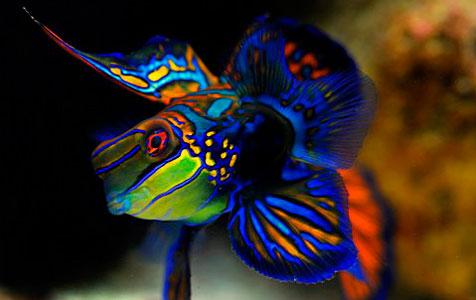
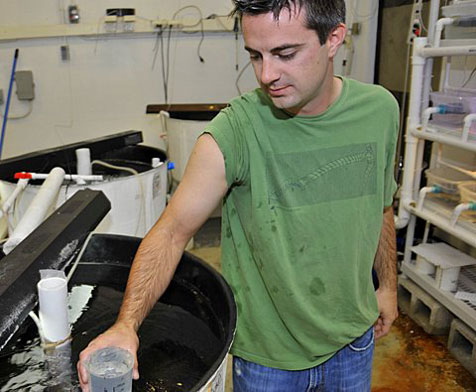
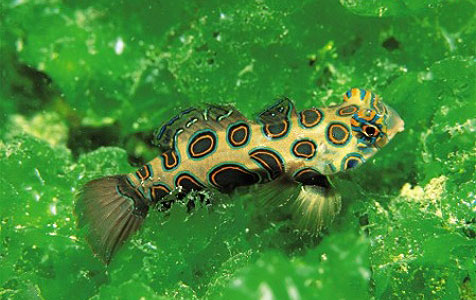
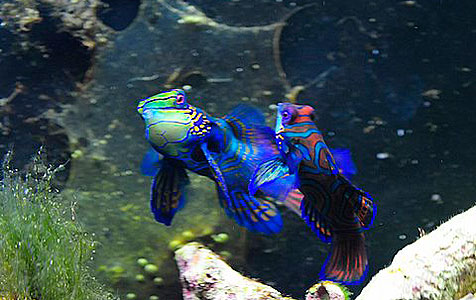
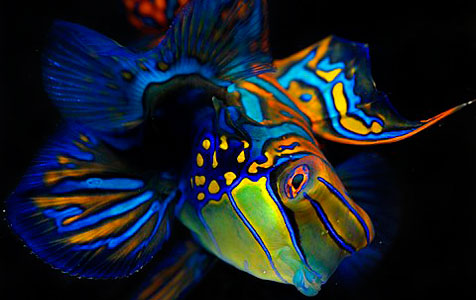
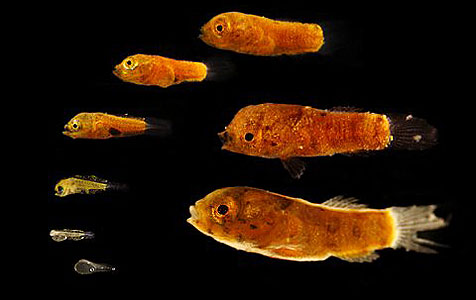
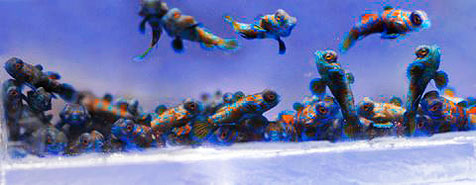
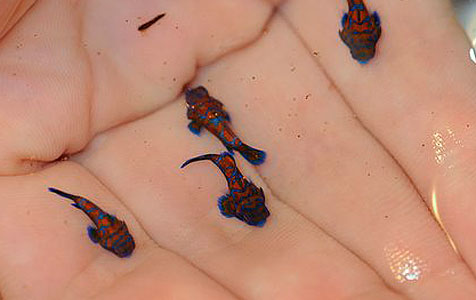
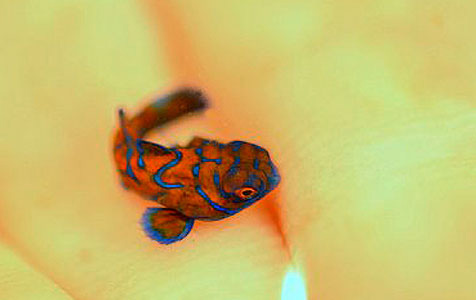





Trackbacks/Pingbacks